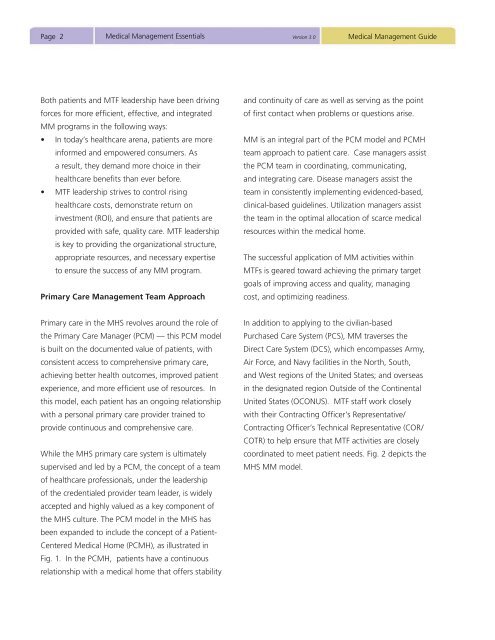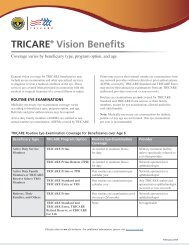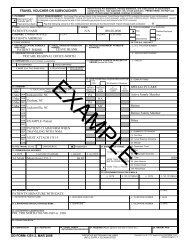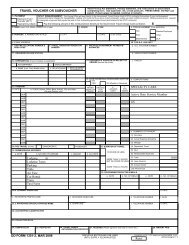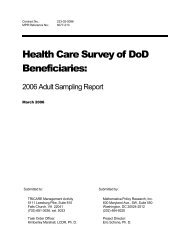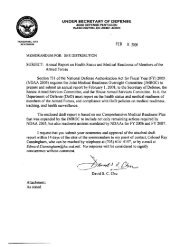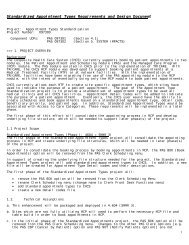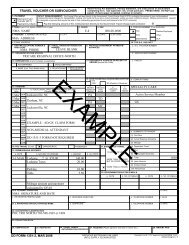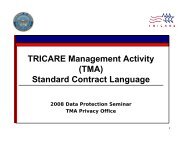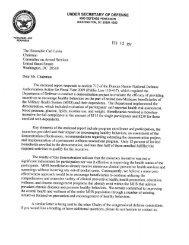Medical Management Guide, 2009, Version 3.0 - Tricare
Medical Management Guide, 2009, Version 3.0 - Tricare
Medical Management Guide, 2009, Version 3.0 - Tricare
- No tags were found...
Create successful ePaper yourself
Turn your PDF publications into a flip-book with our unique Google optimized e-Paper software.
Page <strong>Medical</strong> <strong>Management</strong> Essentials<strong>Version</strong> <strong>3.0</strong><strong>Medical</strong> <strong>Management</strong> <strong>Guide</strong>Both patients and MTF leadership have been drivingforces for more efficient, effective, and integratedMM programs in the following ways:• In today’s healthcare arena, patients are moreinformed and empowered consumers. Asa result, they demand more choice in theirhealthcare benefits than ever before.• MTF leadership strives to control risinghealthcare costs, demonstrate return oninvestment (ROI), and ensure that patients areprovided with safe, quality care. MTF leadershipis key to providing the organizational structure,appropriate resources, and necessary expertiseto ensure the success of any MM program.Primary Care <strong>Management</strong> Team Approachand continuity of care as well as serving as the pointof first contact when problems or questions arise.MM is an integral part of the PCM model and PCMHteam approach to patient care. Case managers assistthe PCM team in coordinating, communicating,and integrating care. Disease managers assist theteam in consistently implementing evidenced-based,clinical-based guidelines. Utilization managers assistthe team in the optimal allocation of scarce medicalresources within the medical home.The successful application of MM activities withinMTFs is geared toward achieving the primary targetgoals of improving access and quality, managingcost, and optimizing readiness.Primary care in the MHS revolves around the role ofthe Primary Care Manager (PCM) — this PCM modelis built on the documented value of patients, withconsistent access to comprehensive primary care,achieving better health outcomes, improved patientexperience, and more efficient use of resources. Inthis model, each patient has an ongoing relationshipwith a personal primary care provider trained toprovide continuous and comprehensive care.While the MHS primary care system is ultimatelysupervised and led by a PCM, the concept of a teamof healthcare professionals, under the leadershipof the credentialed provider team leader, is widelyaccepted and highly valued as a key component ofthe MHS culture. The PCM model in the MHS hasbeen expanded to include the concept of a Patient-Centered <strong>Medical</strong> Home (PCMH), as illustrated inFig. 1. In the PCMH, patients have a continuousrelationship with a medical home that offers stabilityIn addition to applying to the civilian-basedPurchased Care System (PCS), MM traverses theDirect Care System (DCS), which encompasses Army,Air Force, and Navy facilities in the North, South,and West regions of the United States; and overseasin the designated region Outside of the ContinentalUnited States (OCONUS). MTF staff work closelywith their Contracting Officer’s Representative/Contracting Officer’s Technical Representative (COR/COTR) to help ensure that MTF activities are closelycoordinated to meet patient needs. Fig. 2 depicts theMHS MM model.


